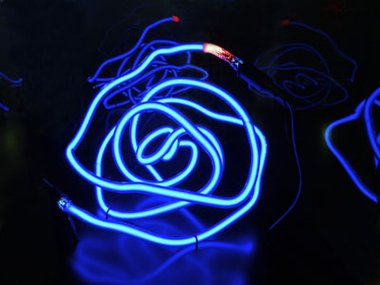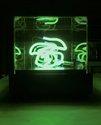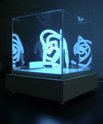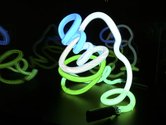John Hurrell – 18 October, 2009
The main point though of Hartigan’s neon work is his love of chroma, the delight he has in manipulating intensely bright, coloured line. While these are also sculptures that provide spatial pleasures for those keen to look at them from different angles, the physicality of this sometimes intensely saturated, linear light provides wonder, even though neon now is dated technology.
Auckland
Paul Hartigan
The Undrawn
7 Oct. - 1 Nov. 2009
In terms of Paul Hartigan’s career this Artis show of neon sculpture is a further development from the Revolution series of circular neon wall reliefs that he made in 2007. The seven works here continue the interest in unravelling knots of coloured light, but now instead of being spirals of several colours projecting out from opaque acrylic discs on the wall, Hartigan has made truly three-dimensional objects that are chunkily compact, and less flattened whorls.
These glowing clusters of cordlike light tumble onto the wooden floors of transparent boxes with acrylic walls. They average about 360 mm wide and look like record turntables with their high, cubed, transparent-but-tinted lids. The lid planes are not flush with the edges of the wooden ‘deck’ but recessed within.
The range of chroma is far more varied than what the images above suggest: some are whiter and icier for example, and others more varied in the temperature of their hue within each loosely poised, spiralling knot-like ball.
There about half a dozen visual variables you can think about when examining these sculptures. First of all, and most obviously, there is the range of chroma, the number of linked up colours within each twisting and buckling line cluster - the joined up sections of coloured or transparent glass within each unravelling nest.
Then there is the form of the configuration, the shape of the spiralling and reversing hovering line itself, the way it might change its alignment from vertical to diagonal, the density of its linear groupings like in a moving spring.
The tinted properties of the acrylic sheets also vary considerably. In one these are dark so that the core threads of the persimmon or orange lines glow menacingly, while their outer edges remain dark and fuzzy.
In many cases, as in the earlier Revolutions, Hartigan has drawn within the glowing line by scratching away parts of the coloured coatings he has applied to the glass tube - or exposing the spiralling transparent tube at its ends, near the caps covering the wiring that ignites the mainly argon (occasionally neon) vapour. Sometimes he incorporates the physical throbbing movement of the gas, so that it can be seen like a twisting worm at the unpainted ends, or subtly detectable within the pastel tube as a gentle pulse.
Often he plays with properties of reflection so that each work’s tumbling neon lines are repeated in diminishing and/or reversed sizes in the vertical acrylic sides, or as a soft muffled glow bounced below off the painted (or unpainted) floor of the box. These qualities in the tinted cubes knock back the sculptural aspects of the tubular forms, dematerialising them by flattening out the spatial and emphasising the linear. This makes the light less bodily, more ethereal and fragmented through repetition, paradoxically accentuating the volumetric properties of the acrylic cube – drawing attention to its flickering walls.
The main point though of Hartigan’s neon work is his love of chroma, the delight he has in manipulating intensely bright, coloured line. While these are also sculptures that provide spatial pleasures for those keen to look at them from different angles, the physicality of this sometimes intensely saturated, linear light provides wonder, even though neon now is dated technology. It doesn’t need to move to make you gasp, but you do (around each cube) if you wish to discover the pleasures of its looping forms - by visually disentangling their internal relationships. It’s a wonderful exhibition, and the best Hartigan show Auckland has had for many years.
John Hurrell





 Two Rooms presents a program of residencies and projects
Two Rooms presents a program of residencies and projects Advertising in this column
Advertising in this column



This Discussion has 0 comments.
Comment
Participate
Register to Participate.
Sign in
Sign in to an existing account.